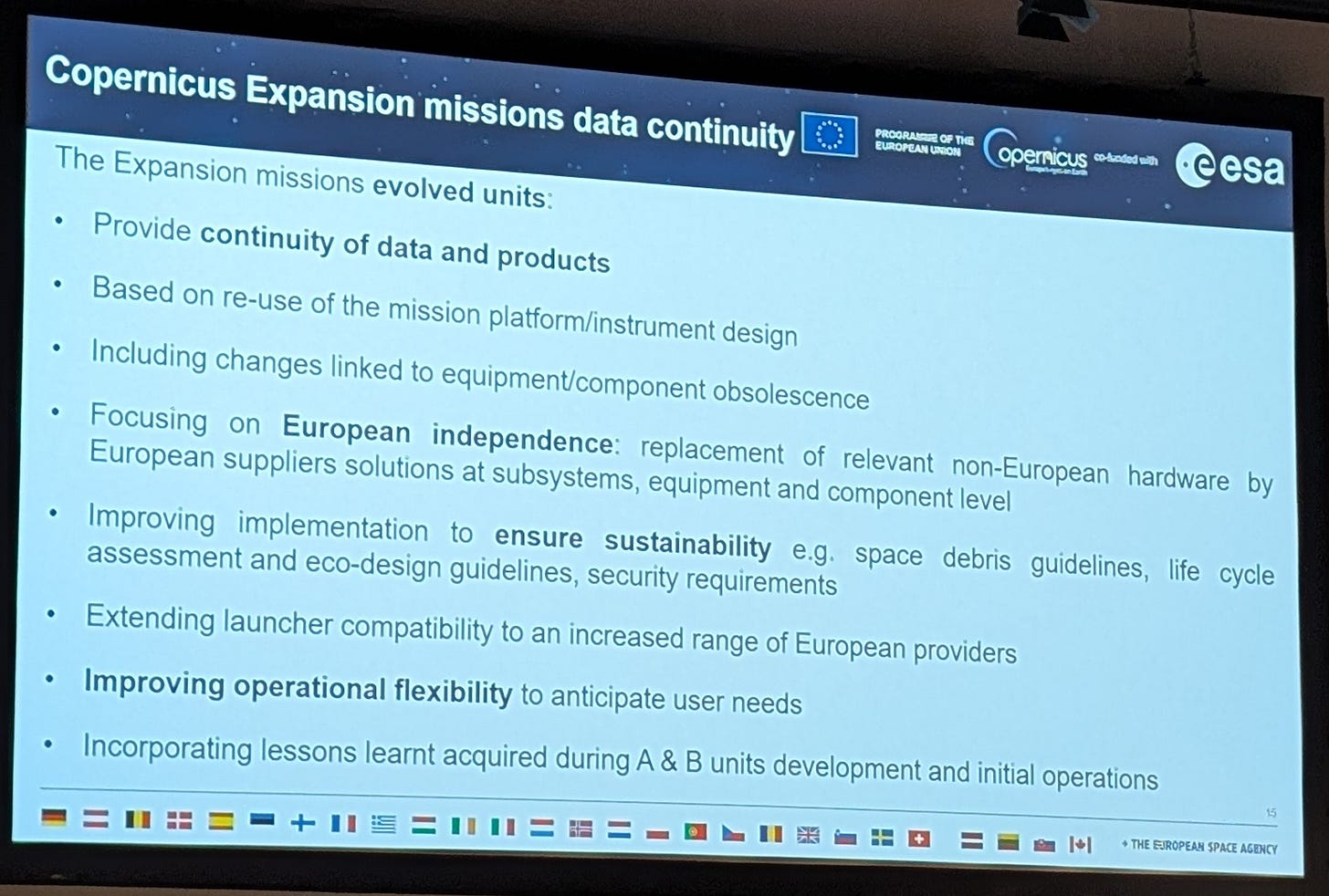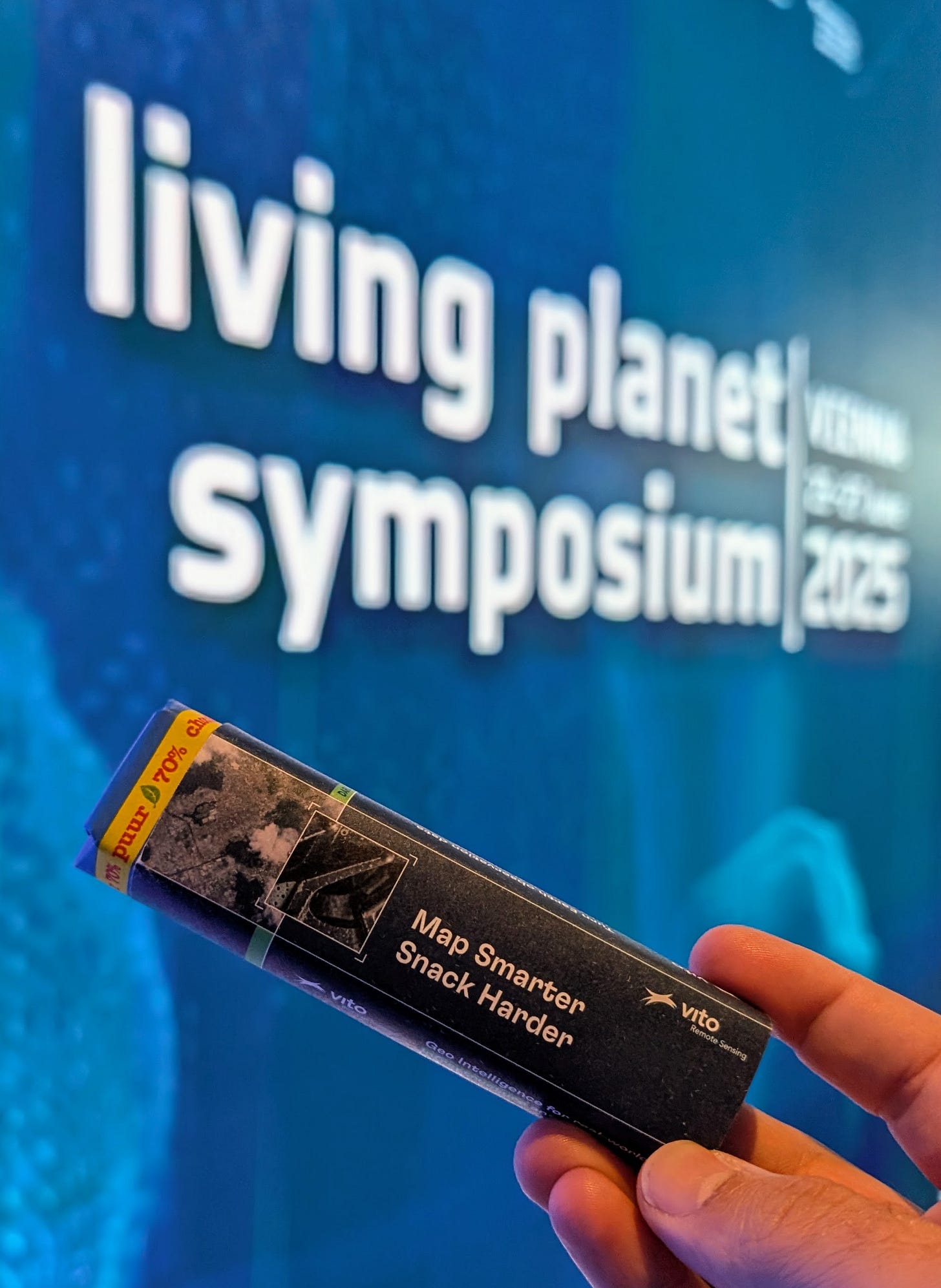It was amazing attending the Living Planet Symposium last week (23–27 June 2025) in Vienna. It’s definitely a fantastic event to get inspired, meet people, have interesting discussions — and nerd out about space!
It’s been just three years since the previous LPS in Bonn (2022), and so much has changed in the meantime. The commercial sector had a much stronger presence this time. ESA's roadmap to ensure Copernicus data extends well into the 2040s, reflects a growing emphasis on long-term continuity. The research landscape has also pivoted: traditional methods are still around (thankfully, far fewer talks and posters using Random Forest), but there's clearly a strong shift toward deep learning and foundation models for EO, bringing in fresh talent from outside the EO bubble.
The Role of EO in a Changing World
“Without access to satellite imagery, we’d be attempting to serve the world blind.”
This is what Aarti Holla Maini, Director of the United Nations Office for Outer Space Affairs, said in her speech at the opening plenary session.
The world is facing challenges on many fronts: climate change, pollution, biodiversity loss, food security, not to mention geopolitical tensions. Satellites — and Earth Observation (EO) more broadly — are not just tools; they are our eyes in the sky, enabling better decisions, faster responses, and more transparent monitoring of the planet.
Or as Diana Ürge-Vorsatz, Vice-Chair of the IPCC, beautifully put it:
“Sentinel-2 is a daily witness of our planet's beauty, fragility and change.”
The Bigger Picture
The “Geopolitical Situation” & European Independence
Josef Aschbacher, ESA's Director General, made it clear: Europe needs to step up its space ambitions and invest more in space programmes to catch up with the U.S. and China.
The conversation around strategic autonomy and technological sovereignty in space is becoming increasingly central. Europe has been working to strengthen its independent access to space — Ariane 6 is one part of that — but now we’re seeing a push for replacing non-European hardware with European-built components, driven by the current geopolitical climate.
Meanwhile, across the Atlantic, NASA is going through budget cuts — and that’s not just affecting NASA’s own missions, but also joint missions with other agencies. This includes potential impacts on Sentinel-6C. [link].
The budget cuts were visible at LPS too. Several sessions that were supposed to feature NASA researchers ended up half-empty. One session had eight scheduled speakers; only three presented.
10 Years of Sentinel-2
On June 23, 2025, exactly ten years to the day since Sentinel-2 was launched, a dedicated session celebrated its anniversary. We got a glimpse behind the scenes with personal stories and photos from the original teams. It was genuinely moving — the passion, the nostalgia, and the pride filled the room.
One thing everyone seemed to agree on: Sentinel-2 is the most popular and widely used European mission to date.
Beyond Land: Methane Monitoring with Sentinel-2
Although Sentinel-2 was originally designed for land applications, it’s been interesting to see how many new and sometimes unexpected uses have emerged over the past decade.
One example came from Itziar Irakulis Loitxate (IMEO, UNEP), in her talk “From Data to Action: Reducing Methane Emissions with Sentinel-2.” She presented how Sentinel-2 is now being used to detect methane plumes.
Through the Methane Alert and Response System (MARS), IMEO processes over 500 Sentinel-2 images per day, identifying around 100 methane plumes each month. What makes this work notable is that the detections are sent directly to governments and operators — turning them into actionable alerts. One example involved a persistent leak in Algeria. After IMEO reported it and followed up, the leak was addressed. The estimated impact was comparable to removing 500,000 cars from the road for a year. [link]
Data continuity in the 2040+
One of the recurring themes throughout the week was data continuity for the Copernicus programme. ESA has laid out a solid and ambitious roadmap to ensure Copernicus data extends well into the 2040s, building on the success of the current Sentinel missions through a combination of Next Generation (NG) missions and expansion missions. [link]
The Sentinel-2 NG mission will feature increased spectral bands, higher spatial resolution, and potentially even night-time observation capabilities.
Similarly, Sentinel-1 NG is planned with higher resolution, a wider swath width, and other improvements.
This stood in stark contrast to the situation across the Atlantic. While ESA is pushing forward with a long-term vision, the future of Landsat Next — NASA’s plan for continuity of Landsat data — is under threat due to budget cuts. NASA has been asked to restructure the mission and explore more affordable alternatives, putting the long-term availability of open U.S. optical data into question. [link]
ESA, on the other hand, is preparing to make the case for Copernicus expansion funding during the upcoming ministerial council meeting in November. It’s an ambitious plan, but one backed by strong user community feedback — a key ingredient in justifying the investment.
The Commercial Sector at LPS
It’s worth remembering that ESA, NASA, and other space agencies primarily launch science missions. But this year at LPS, perhaps more than ever before, we saw a surge in commercial missions that mirror or complement agency-led ones.
Thermal missions are a good example. While ESA is preparing to launch LSTM, and ISRO/CNES are working on TRISHNA (with NASA having originally planned SBG but potentially impacted by recent budget cuts), the commercial landscape is expanding with missions from companies like OroraTech, Hydrosat, SatVu, constellr, Aistech Space and others — all bringing their own thermal offerings into orbit.
The same applies to hyperspectral missions. Alongside missions such as EnMAP, PRISMA, and ESA’s upcoming CHIME, we now see commercial alternatives emerge: Planet’s Tanager constellation, Kuva Space's Hyperfield missions, and more — each aiming to bring high-frequency, high-resolution, hyperspectral data to market.
The sessions on Fire Detection and Monitoring from Earth Observation Data for Rapid Disaster Response featured several contributions from OroraTech — so much so, it could have almost been called “The OroraTech Session.” A particular highlight was how their data — for example, from FOREST-2 — complements public satellite missions. It stood out as a strong example of how combining commercial and public EO data can support actionable applications like wildfire detection and rapid response.
Another notable theme was the growing cooperation between agencies, academia, research centers, and the commercial sector. This blending of roles signals a shift: as new science missions come online, commercial missions are increasingly orbiting alongside them, offering complementary capabilities and helping bridge the gap between research and real-world impact.
But what we need isn’t just more satellites…
Still, bridging the last mile — from raw imagery or analytics to usable, sector-specific insights — remains one of the biggest challenges. That’s where much of the pressure now lies for the commercial sector: to not just deliver data, but to translate it into insights that fit real-world applications.
AI Alone Isn’t Enough
In recent years, Earth Observation has been closely intertwined with advances in AI — sometimes even leading the way [link]. But this growing focus on machine learning has come with a downside: many studies now seem more interested in showcasing the model than in understanding the Earth.
This concern was even raised during a plenary session — that what looks like a novel finding in a model’s output may, in fact, be something long known in the EO community.
We’re often presented with a model, a few metrics, and a couple of nice-looking maps — but with little effort to validate, interpret or ground the results in domain knowledge.
EO research shouldn’t be driven by AI expertise alone. It needs domain understanding — the kind that can question the inputs and interpret the outputs.
Final Thoughts
The Living Planet Symposium 2025 offered more than just updates on missions and methods — it captured the momentum, uncertainties, and vision for the future of the Earth Observation field.
For me, LPS is a celebration of what can be achieved when we work together. It’s not just a gathering to attend one more session; it’s a testament to international cooperation: agencies, researchers, engineers, and private companies all coming together to push the boundaries of what’s possible.
The conversations at LPS reminded me that Earth Observation isn’t just about observing the planet — it’s about understanding it, protecting it, and acting on that knowledge. After all, the satellites we rely on are called Sentinels for a reason: they’re guardians, watching over the Earth to help us respond, adapt, and safeguard what matters most.
See you at the next one.
Let’s Hear Your Highlights
LPS2025 was massive — it was hard to keep track of everything happening!
I’d love to hear what stood out for you.
Feel free to fill out this super short form (it’s really just one question!) about your favourite sessions, talks, posters, or takeaways. [link]
P.S. At the next LPS, I strongly encourage all exhibitors to follow the example of VITO (and ECMWF) — more chocolate at the stands, please.












Loved this! Didn't attend LPS, hope to in future. You made really nice overview with some genuine insights, thank you!
"many studies now seem more interested in showcasing the model than in understanding the Earth" - That's an interesting insight. One of many in this great synopsis! Thank you for this.
Not least is the insight into the perfect exhibitor table giveaway. No waste, just deliciousness!